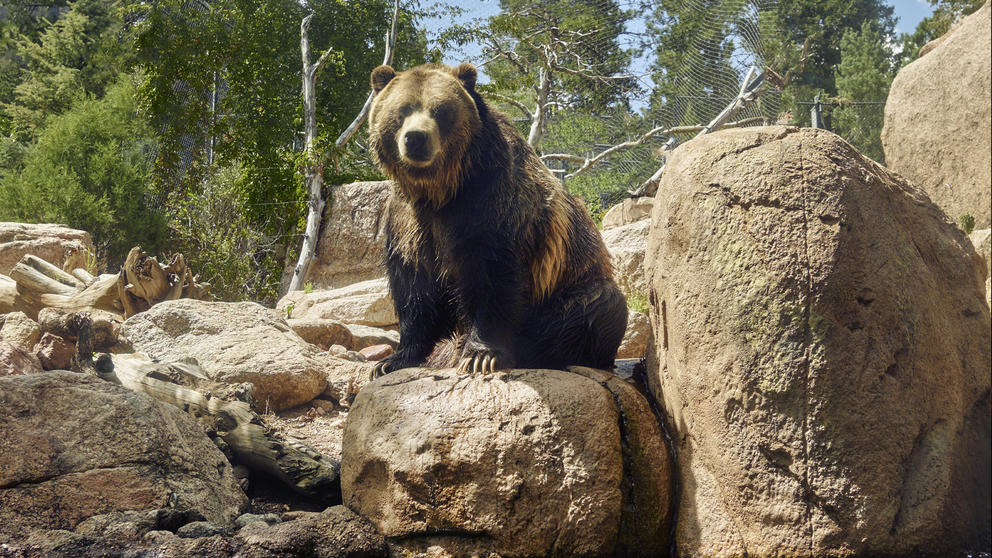Ursus arctos horribilis was well known to Native peoples in the West long before they were given Greek and Latin names. Bears featured in Indigenous experience, art and stories. Tribes throughout the Northwest had distinct words for the grizzly and the more ubiquitous black bear. Necklaces of impressive grizzly talons — much longer and more deadly than a black bear’s claws — were highly prized and traded. Masks and dances featured grizzlies. They were part of the traditional diet of mammals of peoples like the Upper Skagit.
Millennia ago, grizzlies were more widespread in what is now Washington. They were hunted with spears and arrows long before guns came west. There is archaeological evidence that 10,000 or more years ago they were in Puget Sound country, as bones found on Whidbey Island attest.
Rumors of the great bear filtered back east, but they were more legend than fact among Euro-Americans until the early 19th century. When the Lewis and Clark expedition headed west overland to the Pacific Ocean, the grizzly was about to become real to the rest of America.
Part of Lewis and Clark’s charge was to gather information about the new species they encountered. In the spring of 1805, after hearing stories about the grizzly bear’s fierceness and seeing enormous tracks, the expedition finally started to encounter grizzly bears themselves. On May 5 along the Missouri River in eastern Montana, Capt. William Clark and another man killed a large grizzly — “a turrible looking animal,” Clark wrote. They recorded that the bear weighed 500 to 600 pounds and was over eight feet in length, “a most tremendous looking animal and extremely hard to kill notwithstanding he had five balls through his lungs and five others in various parts.” The wounded bear swam halfway across a river to escape before dying on a sandbar, roaring throughout his long death throes. The explorers ate the bear and boiled its fat, finding that it hardened solid like lard. Bear fat became the expedition’s favorite cooking oil.
The expedition encountered and killed a number of grizzlies until they got over the mountains to Oregon and Washington, where they encountered none on their way to the mouth of the Columbia River. But their accounts of the bears on their return east shaped public awareness with the impression that the way west was populated by a fearsome predator.
Researchers today have combed 19th-century records of the fur trade to try to discover where the grizzlies’ population in Washington was at that time.
The Hudson’s Bay fur trading company accounts give a partial answer. Focusing on trading posts that bracketed the Cascades ecosystem, Forts Langley and Thompson in B.C.; Colville, Okanogan and Nez Percés in eastern Washington; and Nisqually on Puget Sound, researchers found that between 1826 and 1857 some 3,188 grizzly bear pelts were traded at these posts. The vast majority, nearly 2,700, were from Fort Colville.
These records are incomplete, and some of the grizzly pelts might have come from farther afield. But they offer evidence that grizzly bears were in and around the North Cascades ecosystem. They were already virtually absent from the western Washington lowlands, however. Fort Nisqually reported only two pelts in those same three decades.
As settlement spread, and single-shot muskets gave way to more frontier firepower, what grizzlies there were largely killed off by settlers, ranchers and hunters. In 19th-century newspapers, the grizzly was often described as “monstrous.” The last stand of the grizzlies seems to be east of the Cascade crest in places like the upper Stehekin Valley, Ross Lake, Entiat Meadows and Chelan. In 1888, an account of a grizzly being shot in the foothills near the Nooksack River reported that grizzlies were “quite numerous in the mountain fastness of the Baker range.” But by 1923, one report estimated that only 22 grizzlies remained in Washington and Oregon.
The last known grizzly killed in Washington’s North Cascades was in Fisher Creek Basin, south of Ross Lake, shot by a hunter in 1967. Despite a few grizzlies in the northeastern Selkirk range on the Washington/B.C./Idaho border and a possible few in the North Cascades, over 200 years of white settlement the grizzly was essentially extirpated from Washington.
Not everyone would welcome grizzlies back — the other apex predator, the wolf, has returned to Washington, and some folks are not happy about that. Bears and wolves can prey on livestock. Some fear the outdoors will be made less safe for recreation.
The North Cascades, with nearly 16,000 square miles of wilderness, is one of the only large wild areas left in the lower 48 that could theoretically support a large population — perhaps as many as 250 grizzlies, more than are found in Yellowstone National Park today. That would be decades from now. But a recent report indicated that climate change might actually expand habitat for grizzlies in that area. Could a warming planet aid their comeback here?
The world is full of surprises.




